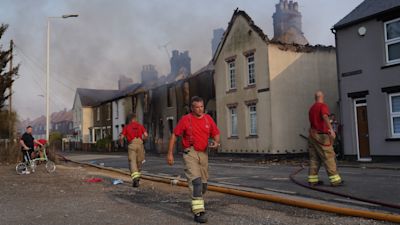Explainer
Why we will see more devastating wildfires like those in Wennington and South Yorkshire in the UK

by Digital Producer Suzanne Elliott
Huge wildfires have destroyed homes and swathes of land across the UK amid record-breaking temperatures and dry weather.
After temperatures topped 40C for the first time in UK history, major incidents were announced by fire brigades across the country as dozens of blazes broke out in the searing heat, ripping through houses, businesses, schools and churches.
Tuesday was the busiest day for London Fire Brigade (LFB) since the Second World War, with the service experiencing more than seven times the usual volume of calls, said London Mayor Sadiq Khan.
Wildfires have also been raging across Europe, and have become more ferocious in recent years in the US and Australia where forest or bush fires are more common,
How do wildfires start, are they linked to the climate crisis and are we likely to see more scenes like we saw this week in the future?
What is a wildfire?
A wildfire, also called a forest fire, bushfire, wildland fire or rural fire is an uncontrolled and unpredictable fire often in an area of vegetation but which can also consume residential areas.
Wildfires need three conditions to take hold: fuel, oxygen, and a heat source.
They spread rapidly, fuelled by dry vegetation and parched earth.
They are most common in countries whose climates are moist enough to allow the growth of trees, but feature extended dry, hot periods, such as Australia and the US, notably California.
Higher temperatures dry out vegetation - and dry vegetation is easier to ignite leaving it vulnerable to fire.
How do wildfires start?
Wildfires are often caused by people - sometimes deliberately but lightning or a tiny spark - in the right conditions - could set off a fire.
The higher temperatures dry out the vegetation and this greatly increases its flammability. Hot weather with little rainfall increases the likelihood of wildfires. Once alight, the dry vegetation fuels taller flames that spread fast.
Dr Rory Hadden, Rushbrook Senior Lecturer in Fire Investigation, University of Edinburgh, said: “Periods of hot dry weather result in perfect conditions for fires in vegetation to grow and spread rapidly. In addition increased recreational activity in these areas of vegetation will lead to more fires starting."
As the UK recorded a new top temperature of 40.3C, conditions were ripe for wildfires.
Dr Thomas Smith, Assistant Professor in Environmental Geography, London School of Economics (LSE), said: “The fire risk was extreme, with record-breaking temperatures accompanied by very low relative humidity, this coming on top of a very long spell without rain. This can lead to extreme fire behaviour with fast-spreading fires burning with high intensity (large flames), making it very difficult to fight.”
Aerial footage show the devastation caused by the Wennington fire
Will the UK see more devastating wildfires?
As the climate changes, temperatures like those we saw in the UK saw on Monday and Tuesday will no longer be unusual, increasingly the likelihood of ferocious fires.
"Climate change is increasing fire danger across the UK, and we need to be prepared for it," Prof Nigel Arnell, Professor of Climate Change Science, University of Reading, said.
Dr Hadden said that fires, like the one seen in Wennington, east London that ripped through houses, are of " particular concern".
"Many parts of the world (USA, Southern Europe, Australia) are impacted by these so-called Wildland Urban Interface fires (in the area where housing and structures mix with, or are next to, vegetation) regularly. Usually in the UK large wildfires are confined to relatively remote areas such as heath and moorland," Dr Hadden said.
Want a quick and expert briefing on the biggest news stories? Listen to our latest podcasts to find out What You Need To Know
He continued: "The recent weather has shown that as the climate changes, the UK will be susceptible to these kinds of fires which can be extremely devastating with impacts on structures, communities, wildlife and life safety.
"The exact impacts will vary and we are still learning about these in the context of the UK, but we should expect more and larger wildfires as we experience longer and hotter spells of dry weather. "
What can we do to prevent wildfires?
Heatwaves are made more intense and frequent mainly because overall temperatures are higher due to global warming, and so, when weather systems such as summer high pressure occur, the heat they bring is amplified.
Scientists and experts in the UK are working to help plan for, and reduce the effects of wildfires using engineering and ecological techniques, but, as Dr Hadden said, "we also need to recognise that actions of individuals will ultimately be the key to managing the risks presented by these fires".
"Wildfires are best fought before the start, via prevention and management of the natural resources,” Prof Guillermo Rein, Professor of Fire Science, Imperial College London, said.
Cabinet Office minister Kit Malthouse said the UK was likely to experience more of these incidents, such as wildfires, and that "we should not under-estimate their speed, scope and severity".
MPs have called for a ban on disposable barbeques and Chinese sky lanterns which could spark a blaze on tinder-dry grass.